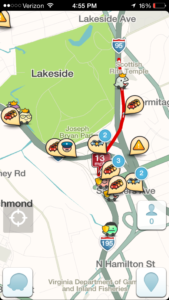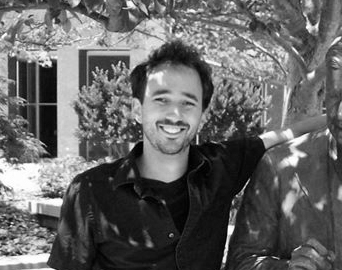A few weeks ago, I decided to download a Google-owned navigation app called Waze. I’d heard a lot about it from friends, and I figured it wouldn’t hurt to try it out. Coincidentally, I went on a trip to Delaware last week and I was able to put it to work.
How did it fare?
Well, I quickly found that it was accurate. Creepily accurate. Road hazards, cars parked on the shoulders of highways, construction sites and unexpected detours…these conditions and more were geotagged within the mapping software by other users in order to alert their fellow Wazers (if that’s even a word). One particular notification stands out in my mind from my drive back to Richmond yesterday: the app alerted me with a message that said “Hazard: shredded tire” that was supposed to materialize in 0.4 miles, and when I was 0.2 miles away I was able to see the piece of rubber right in the middle of the highway, allowing me to swerve around it with ease.
My girlfriend was my co-pilot during my travels last week, and I had her tagging things that as we drove along. Car accidents, potholes, and an 18-wheeler that was blocking a three-lane road as it unloaded goods were my contributions to the crowdsourced collection of “look out!” alerts. And yes, she “liked” the aforementioned tire hazard.
However, one feature that was particularly intriguing for me has also stirred up a heap of controversy: the ability to tag hidden and visible police vehicles. As I drove through the Delaware countryside, I was able to see little “police” icons that had been pinned onto particular spots on the map, thus allowing drivers to anticipate potential speed traps and problem areas. I was actually very amused by this tool… at one point, a number of cars that were driving much faster than I was tapped their brakes and slowed down about ¼ of a mile before one of the geotagged police cars were parked in a hidden spot in the median of the highway. The car was not visible when they initially hit their brakes.
How is it that I can assume that these drivers were using Waze? The short answer is that you have the ability to see other users on your map, and there just so happened to be the avatars of a little sunflower with wheels and a nerdy-looking ghost-mobile right in front of my car.

While this may seem like a gift from the heavens for drivers looking to gain Professor Xavier-like abilities, police around the country have warned of the dangers of such an feature. One particular incident that propelled Waze into the national spotlight (in a very negative way) was the discovery that the man who killed two NYPD police officers in December had been using the app to track police officers only hours before the shooting. LAPD Police Chief Charlie Beck sent an open letter to Google in the wake of the shooting, arguing that he was “concerned about the safety of law enforcement officers and the community, and the potential for your Waze product to be misused by those with criminal intent to endanger police officers and the community.”
There is another police perspective, though, which is that people who are aware of a heavy police presence in their area will drive more slowly and safely, thus accomplishing the true goal of the officers who utilize radar detectors. It’s like the modern-day version of flicking your headlights to alert other drivers, but in this case your headlights have over a 1-mile radius and they come with “like” buttons.
It’s hard to say whether or not the police-tagging feature does more harm than good. There are plenty of things in life that can be twisted to serve the needs of nefarious people, but that doesn’t mean that there needs to be a mass child-proofing initiative. I do think that people will be more alert and will drive more safely if they have advanced notice of things in their way. After driving without the app a few times yesterday, it actually felt a bit weird not being able to anticipate things.
So much of our digital society revolves around location-based interactions nowadays, for better or worse, and Waze manages to create yet another mini social network that givers users the ability to rank up by completing objectives like “Resolve 50 map problems” and “Drive 500 miles within a week.” Earning points to level up your individual Waze (a ghostly avatar that can be given moods for the low low price of 100 miles driven while using the app) gives users the incentive to keep their eyes open and their fingers tagging. When they’re not driving, of course. That would be dangerous.
Since I’d never considered a driving/navigation social media experience a few years ago, I wonder what kinds of experiences are still out there that will inevitably receive a Waze-like treatment. Birdwatching? Boating? Maybe stargazing? I can see it now: hundreds of thousands of users looking at the sky via their choice “night stars” app, tagging the ones they see and liking anyone else’s status if they happen to be looking at the same constellation.
On second thought, that sounds horrible.
I digress. It goes without saying that Waze has a lot of potential to alter the way people get from point A to point B. I feel that these types of services will actually evolve into more advanced functionalities that come standard in cars in the future; after all, many already come equipped with blindspot protection and front and rear sensors. It wouldn’t be that hard to add publicly-identified road hazards into the mix. Just think: instead of experiencing that shocking feeling when your car’s tires drop down into a particularly brutal pothole, your car’s alert system would notify you (in some way or another) that there are issues with the pavement you’re driving on. That information could even be provided by the city itself through their transportation and maintenance departments, assuming they’re competent and efficient enough to complete even the most basic day-to-day activities.
I only hope that I’ll still be able to rank up, somehow. Swerving around potholes, dodging roadkill, slowing down in speed traps and construction zones, and successfully avoiding any other types of hazards could soon be called The Kia/Ford/Chrysler/Fiat/Porsche/Etc. Agility Challenge or something, and the best drivers could be featured in a new show airing Monday nights at 7:00 pm called Road Warriors (hosted by Ryan Seacrest, of course).
And yes, I expect to be paid for that brilliant idea.


